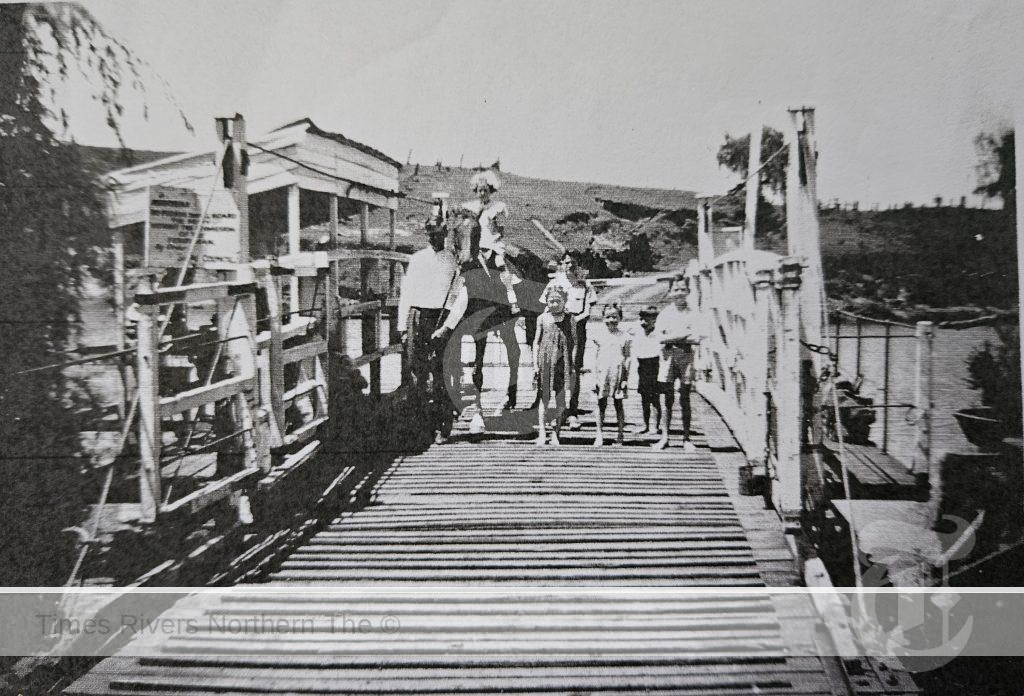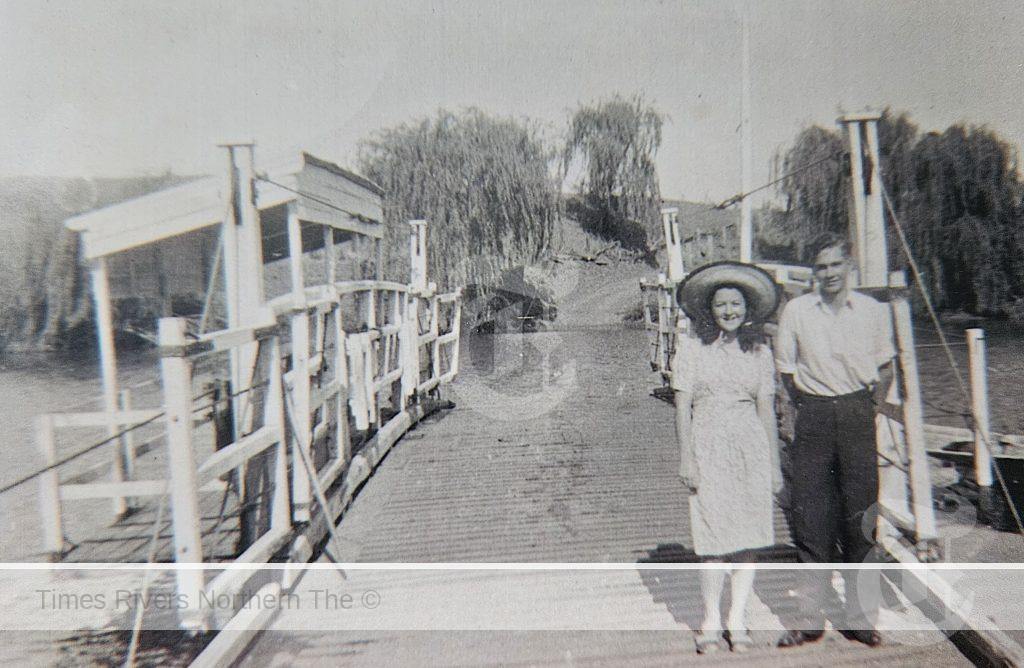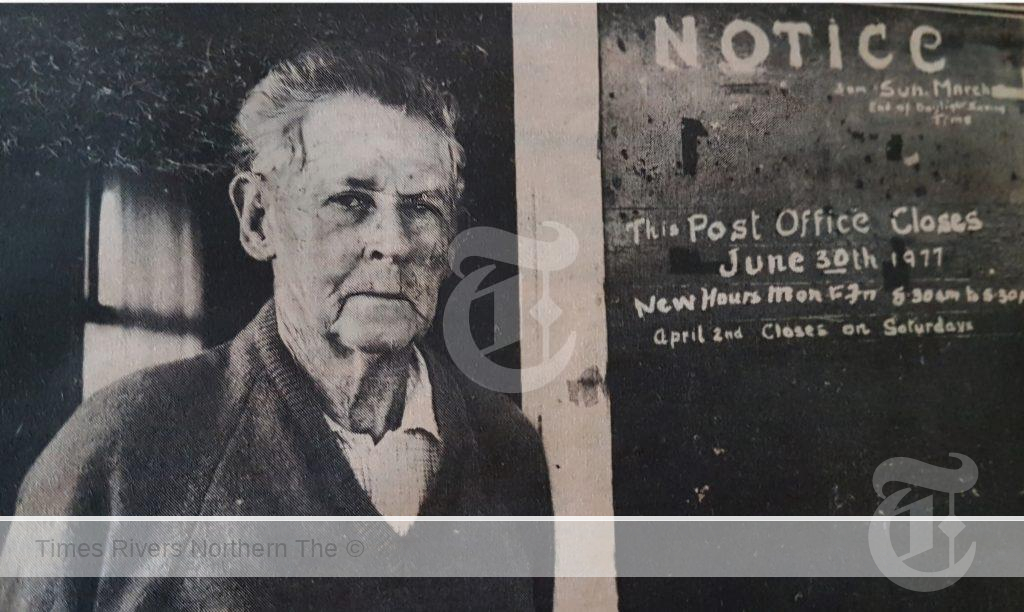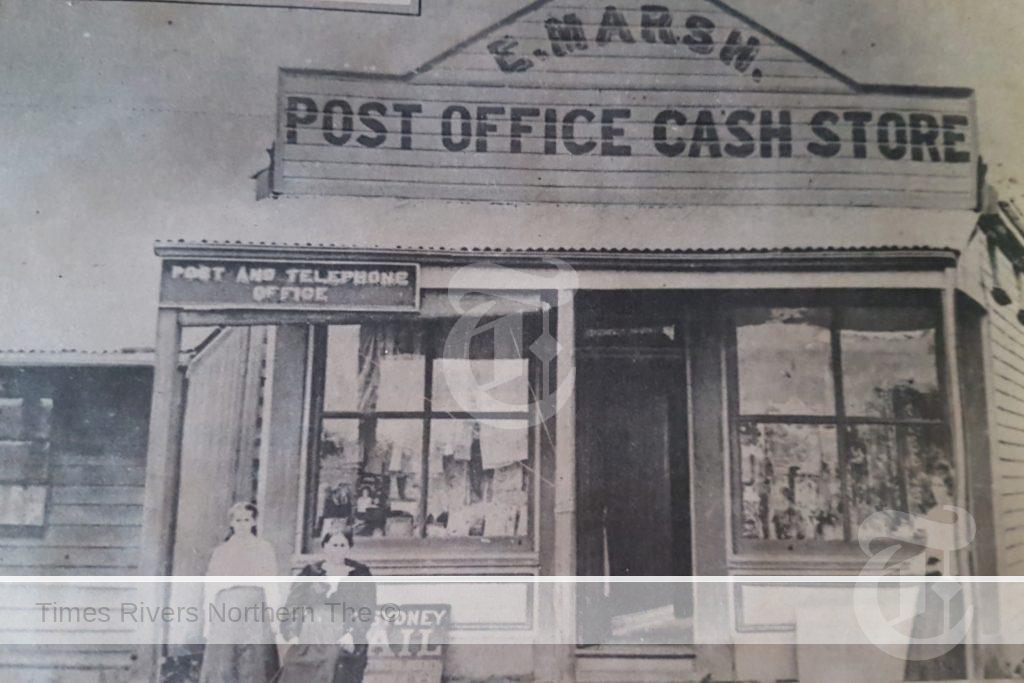TATHAM FERRY
By Helen Trustum
In the early days of dairying in the Richmond Valley, river boats played an important role in the transport of cream from dairy farms to the factory. Cream boats provided a service to farms that were often difficult to access by road and easily isolated in times of flooding. The cream boats traversed to the Richmond River from Woodburn to Coraki, before returning to Coraki and travelling up the Wilson River to Lismore.
As stated in the Richmond River Herald 16/3/1909 The Coraki / Tatham people were overjoyed when they were getting a ferry to operate across the river at Tatham.

Tatham Ferry – Johnny Schneider, Jill Barnett ( on horse), Ted Richardson, Johnny and Janice Patfield ( near horse). Photo supplied by Jill Barnett.
A large number of townspeople met at the Coraki Rowing Club Shed to witness the launching of the new ferry built at the order of Tomki Shire, by Alf Conroy for the ferry service at Tatham. The new punt, which was decorated with flags, entered the water with a resounding smack, though very little spray fell on the deck. After the craft had been launched everyone made to the Rowing Club Shed where bottles were uncorked and the Engineer of Woodburn Shire, Mr A Adams proposed a toast to ”The Punt”. Mr Adams remarked: that he had taken a keen interest in the building of the punt. He congratulated both Tomki and Woodburn Shire on sourcing such a first class punt and trusted that it would have a long and successful career in the ferry service at Tatham.

Tatham Ferry – 1950. Fred Murphy and Kathleen McFadden ( first cousins)
The punt measured 30 feet in length (9.15 metres), 12 feet 3 inches(3.75 metres) beams and 3 feet deep (91.5cm) with two 9 feet flap (2.75 metres).. The outside planking was built of Oregon pine, while the deck and upper works were hardwood. The ferry was sheathed with galvanized iron and carried three coats of tar inside and out. It was indeed one of the staunchest punts on the river and every way a credit to the designer Mr Kirkpatrick and builder Mr Alf Conroy.
On 16th December 1913, The Public works acknowledged approval of receipt of tender for one hundred and forty pound, eight shillings to J.H. Easterbrook for working on the ferry.

Tom Marsh at Tatham Post Office – 1977
Ferryman, in 1917 was Mr J. Birmingham. He was given approval on 17th September 1917 for working the Tatham Ferry at 164 pounds and 5 shillings per year. Although it was not the lowest tender but a very popular one as Council had received a signed petition in his favor. President, Mr Sullivan, said he had explained the position to the Department in Sydney and they had said, they would like a returned soldier to work the punt.
The punt was almost on the boundary of Gundurimba Shire and visitors to the area used the punt almost as much as the ratepayers. For that reason, he did not think Tomki Shire should be saddled with the whole expense.
The Tatham Ferry was in service until 11th January 1968 then a new bridge was being built starting on 22nd October 1963.

Tatham Post Office
Memories:
Frank Brown (now deceased): who was 92 years old at the time in 2020 remembered the great times as a lad growing up at Tatham, when the young ones of the district would meet at the Tatham Ferry and go swimming. This would happen every Sunday during summer. The ferry driver Gus Lewin would park the ferry in the middle of the river so the children could dive off. All the time watching for cars. They included children from Browns, Magners, Hancocks, Lyle and Kevin Clarke and Neville Cowan.
Frank also remembered the teacher from Pidcocks Lane School, which was over the river from the Brown property. Her name was Sally Rankin. Sally later married George Cox from Tatham. Each school day Sally would ride her horse from their property (known as Ray Mison’s) across the little ferry at Tatham and down to Pidcocks Lane School.
Jack Donovan (now deceased): In those early days of settlement at Tatham, Jack Donovan recalled in notes that it was necessary for a crossing at Tatham. The ferry consisted of pine and cedar chained together and a rope was fastened to trees on both sides, so it could be pulled over.
Joe Rathbourne was the first man to build a hotel at Tatham, on the south bank close to the wharf. The river near the wharf was a popular spot for swimming. A swimming club was formed in the 1920’s.
During flood times, great care had to be taken with the ferry disconnecting the rope so the ferry could be pulled up on to the bank to stop it being washed away. The main rope had to be dropped further down in the river so all boat traffic could pass by.
There was a bell that people could ring to alert the ferryman. This bell was given to the Casino Public School.
Tom Marsh (now deceased): Some early reflections from Tom Marsh from his notes:
Wharf was built by Mr Rankin on the south bank. There was also a store, hotel, blacksmith, saddler’s, fruit shop, bakers, George Smith Bootmaker and Mr Wilson’s Creamery.
The village was built in a very flooded area. 1887 “Big Flood”, 1891, 1893, !921 “Big Flood”, March 1931, then a series 1945, 1948 and the big one 1954.
Tatham Public School opened at The Red Hill, at Tatham, Johnathan McInnes was the teacher. Convent School opened in 1906 with a few desks in the back of the church. School Hall was built in 1908.
Marie Kempton: The family all had fun swimming off the ferry, that was all the “Tatham-ites”. They were O’Donnells, De Lewins, Wares, Eckerts and the Parkers. During the 1954 flood, Marie along with her family, the Small’s, took refuge on the road outside Parkers house.
Colleen Knight: Gus De Lewin was one of the ferry operators also the cream carrier. His family Sonia, Jo, Florence and a younger one would help him on the cream truck.
Ferry Drivers: Harry Windsor, Nugget and Archie Lamont, G. Schneider, John Birmingham, Tom Donovan, J. Watts, Gus De Lewin, Bill Leahy, Joe Rathbourne, Albert Avery, J. Frost, J.W. Easterbrook,
Ref: Mid Richmond Historical Society at Coraki, Jack Donovan’s memories, Tom Marsh’s memories, records shared by Elaine Trustum, Tatham.
For more rural news, click here.





 Tweed Shire News2 years ago
Tweed Shire News2 years ago
 Motoring News2 years ago
Motoring News2 years ago
 COVID-19 Northern Rivers News3 years ago
COVID-19 Northern Rivers News3 years ago
 COVID-19 Northern Rivers News3 years ago
COVID-19 Northern Rivers News3 years ago
 Northern Rivers Local News3 years ago
Northern Rivers Local News3 years ago
 Health News3 years ago
Health News3 years ago
 COVID-19 Northern Rivers News3 years ago
COVID-19 Northern Rivers News3 years ago
 NSW Breaking News3 years ago
NSW Breaking News3 years ago































